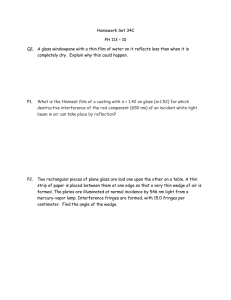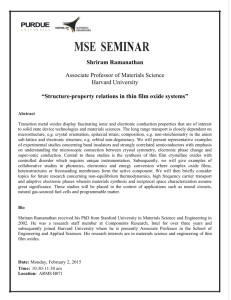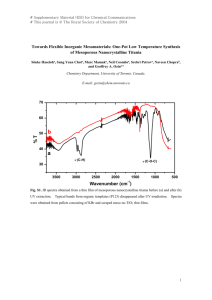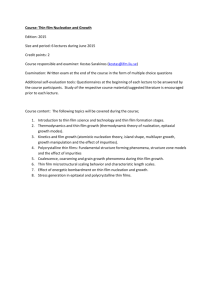ES240 Final Project thin film anode of Lithium-ion battery
advertisement
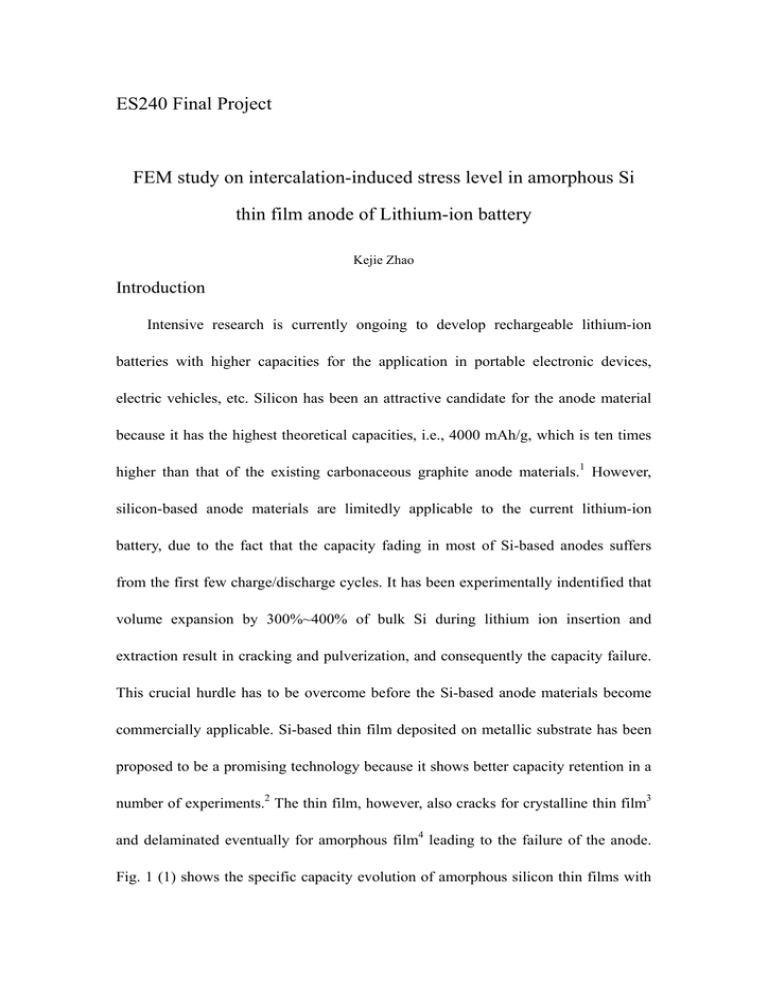
ES240 Final Project FEM study on intercalation-induced stress level in amorphous Si thin film anode of Lithium-ion battery Kejie Zhao Introduction Intensive research is currently ongoing to develop rechargeable lithium-ion batteries with higher capacities for the application in portable electronic devices, electric vehicles, etc. Silicon has been an attractive candidate for the anode material because it has the highest theoretical capacities, i.e., 4000 mAh/g, which is ten times higher than that of the existing carbonaceous graphite anode materials.1 However, silicon-based anode materials are limitedly applicable to the current lithium-ion battery, due to the fact that the capacity fading in most of Si-based anodes suffers from the first few charge/discharge cycles. It has been experimentally indentified that volume expansion by 300%~400% of bulk Si during lithium ion insertion and extraction result in cracking and pulverization, and consequently the capacity failure. This crucial hurdle has to be overcome before the Si-based anode materials become commercially applicable. Si-based thin film deposited on metallic substrate has been proposed to be a promising technology because it shows better capacity retention in a number of experiments.2 The thin film, however, also cracks for crystalline thin film3 and delaminated eventually for amorphous film4 leading to the failure of the anode. Fig. 1 (1) shows the specific capacity evolution of amorphous silicon thin films with different thickness in Li-ion battery as a function of charge/discharge cycle numbers, (2) illustrates that the delamination from substrate leads to the failure of amorphous Si thin film with thickness 250nm after 30 cycles, and (3) shows the thin film with thickness 1um cracked to be islands after 30 cycles though the capacity retention is kept good. Obviously the coupling of fracture and delamination leads to the failure of amorphous Si thin film in Li-ion batteries. b a (1) b (2) (3) Fig. 1: (1) Specific capacity of amorphous Si thin films with different thickness in Li-ion battery as a function of cycle numbers (2) the failure mode of amorphous Si thin film with thickness 250nm after 30 cycles (3) amorphous Si thin film with thickness 1um cracked to be islands after 30 cycles However, the failure mechanism and the physical progress during Li ion insertion/extraction in the thin film are not well-understood to date. It should be pointed out that the most of lithium storage compound exhibit significant volume changes upon electrochemical cyclings, and most electrodes exhibit fracture in use.5 Tab. 1 shows the volume and linear strain for different lithium-storage compounds during charge/discharge cyclings. One can readily estimate the internal stress level based on the assumption of isotropic expansion and contraction. We can also conclude that fracture is a general problem limiting the life time of Li-ion batteries. Tab. 1: Volume and linear strain of lithium-storage compounds during cyclings. In order to better understand the failure modes and corresponding failure mechanism of the electrode materials in Li-ion batteries, especially interested in the mechanical progress involving plasticity and fractures, here I studied intercalation-induced stress level in amorphous Si thin film deposited on copper substrate. The numerical simulation method is adopted by using ABAQUS. The main objectives in this project are as follow: 1): to be familiar with finite element method and ABAQUS. 2): to estimate the internal stress induced by lithium ion intercalation and extraction. 3): to identify the failure mode and the failure mechanism of amorphous Si thin film Numerical simulation Finite element method is adopted in my numerical simulation to study the internal stress level by using ABAQUS. As mentioned in the introduction part, the volume expansion of bulk Si anode could reach 300%~400% during Li-ion intercalation, even for the Si thin film constrained by the substrate material, the volume change could be approximately 100% in the charge process.3 So basically it’s a large deformation problem, which is not an easy task for ABAQUS. Here I studied three cases, case 1 for elastic amorphous Si thin film with small deformation mainly to verify the simulation method and model, case 2 for elastic thin film with large deformation to estimate the internal stress level, and case 3 for elastic-plastic amorphous Si thin film with large deformation, to fully understand the internal stress level in practice. In the simulation process, axisymmetric model is employed to be representative of amorphous Si thin film deposited on Cu substrate. Thermal expansion is included as a load to simulate the volume expansion during intercalation. Case 1: elastic amorphous Si thin film with small deformation In this case, elastic amorphous Si thin film deposited on elastic polycrystalline Cu substrate is studied. The materials properties are listed in Tab. 2. Fig. 2 (a) shows the initial model in the simulation, the thickness ratio of film and substrate is set to be 1, and the ratio of thickness and radius of the wafer is 1:100, to be representative of “thin film”. Fig. 2 (b) is the side view of the model after deformation. Recall that thermal expansion is adopted as a load in the simulation, the volume expansion is set to be 3×10-5. Tab. 2: Material properties of amorphous Si thin film and polycrystalline Cu substrate Young’s Modulus Amorphous Si 80GPa Polycrystalline Cu 130GPa Poisson’s Ratio Thermal Expansion Coefficient 0.22 3×10-6 0.3 --- a b Fig. 2: (a): Initial model representing amorphous Si thin film deposited on Cu substrate (b): side view after deformation. By carefully examining the internal stresses and strains of thin film and substrate, it is found that the stress-strain relation follows Hooke’s Law: εij = 1 [(1 + v)σ ij − vσ kk δij ] + αΔT E (1) where α f = 3×10−6 for thin film material and α s = 0 for the substrate. Similarly we can compare the curvature after deformation with stoney’s analytical formula: k= 12ε m M f hs M s [1 + 14 Mf Ms +( Mf Ms ) 2 ]−1 (2) where ε m is the mismatch strain, hs is the thickness of the substrate, and M f , M s represent the biaxial modulus of the film and substrate material respectively. Mathematically, ε m , M f , M s could be expressed as: ε m = ( α f − α s ) ΔT Ms = Es 1 − νs Mf = Ef (3) 1− ν f where a, E , ν are thermal expansion coefficients, Young’s modulus and Poisson’s ratio respectively. After deformation, the curvature is measured to be approximately 1/45451, which is very close to the analytical value 1/44966. The error is 1.07%. So the simulation model and method are verified to be correct. Case 2: elastic amorphous Si thin film with large deformation Based on elastic assumption I studied the stress level in amorphous Si thin film with 100% volume expansion in this case. Fig. 3 shows the initial model and volume expansion of thin film after deformation. a b Fig. 3: (a) Initial model of amorphous Si thin film deposited on Cu substrate (b): volume expansion after deformation In the initial model, the thickness ratio of film and substrate is set to be 1:100 and the ratio of thickness and radius of the wafer is kept to be 1:100. With the same simulation method in case 1, the internal stress in the thin film could be obtained after deformation. It is found that the Mises stress is approximately 300GPa, which is huge enough to induce fracture in any materials known to date. Curvature of the substrate is also calculated to compare with analytical formula, it is found the error is about 1.19%. It is attributed to the small deformation in the substrate so that the linear theory of elasticity is still valid in this case, though the volume change in thin film is huge. Case 3: elastic-plastic amorphous Si thin film with large deformation I simulated the elastic-plastic amorphous Si thin film deposited on elastic Cu substrate with large volume expansion to be 100%, to study the residual stress level after deformation. The initial model is the same with that in case 2. Material’s Law of thin film follows the deformation plastic theory: Eε = σ + α( σ 2 )σ σ0 (4) where α is the yield strain, and σ 0 is the yield strength. In the simulation α is set to be 0.2%, so σ 0 equals to 160MPa. The elastic properties are shown in Tab. 2. Thermal expansion is also adopted to simulate the volume change. After deformation, it is found the residual stress in the thin film is approximately 15GPa. Conclusions Based on the elastic assumptions, it is found the intercalation-induced stress is about 300GPa, which is huge enough to crack the amorphous Si thin film. Even the thin film is elastic-plastic material, the residual stress induced by the large volume expansion is also high enough to introduce plasticity and fracture in the Si thin film. So it is concluded that fracture, and delamination induced by the mismatch stress on the interface dominate the failure of Si thin film anode in Li-ion battery. In the future work, the plastic behaviors of amorphous Si materials will be under study, and defect would be introduced in the numerical simulation to investigate the physical process on the interface between thin film and substrate material. References: 1. U. Kasavajjula, C. S. Wang, and A. J. Appleby, "Nano- and bulk-silicon-based insertion anodes for lithium-ion secondary cells," Journal of Power Sources 163 (2), 1003-1039 (2007). 2. T. Moon, C. Kim, and B. Park, "Electrochemical performance of amorphous-silicon thin films for lithium rechargeable batteries," Journal of Power Sources 155 (2), 391-394 (2006). 3. L. Y. Beaulieu, K. W. Eberman, R. L. Turner et al., "Colossal reversible volume changes in lithium alloys," Electrochemical and Solid State Letters 4 (9), A137-A140 (2001). 4. J. P. Maranchi, A. F. Hepp, A. G. Evans et al., "Interfacial properties of the a-Si/Cu : active-inactive thin-film anode system for lithium-ion batteries," Journal of the Electrochemical Society 153 (6), A1246-A1253 (2006). 5. Y. Koyama, T. E. Chin, U. Rhyner et al., "Harnessing the actuation potential of solid-state intercalation compounds," Advanced Functional Materials 16 (4), 492-498 (2006).
